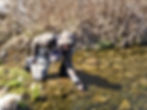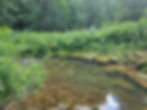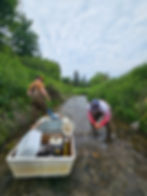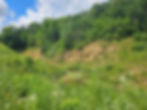Non-Native Trout Removal as a Management Tool for Native Trout Restoration
- Jason G. Freund
- Aug 24
- 11 min read
Kirk Olson, Wisconsin Department of Natural Resources Senior Fisheries Biologist in La Crosse, and colleagues recent paper "Brook Trout population response to Brown Trout removal by electrofishing in a Wisconsin Driftless Area stream" (Olson et al. 2024) was published which lead to this post. In summary, this is a paper about the restoration of Brook Trout and the removal of Brown Trout from Maple Dale Creek in the West Fork of the Kickapoo River watershed, similar to the upper Seas Branch restoration project. In short, when there is a barrier to Brown Trout recolonization, Brook Trout populations boom after the removal of Brown Trout. It is, in many ways, a pretty simple story.

The paragraph above is the short story. This is a classic example of a problem that looks simple on its face, but is more complicated as you dig deeper. The simple part is that there is little question that non-native trout affect native trout. While we know that effects, often we don't know the magnitude of the effect. The more difficult question is, what, if anything, can we do about it? I say this largely because it is a huge, widespread problem across not only Wisconsin, but more or less anywhere that trout are native.

We have a ton of evidence that non-native trout negatively impact native trout. But the magnitude of this effect varies greatly and, like most ecological questions, the "where" has a great effect. I know I keep linking to this post, but it's for good reason. And I could list a ton of papers that demonstrate this (they are in the resources below) but I do not feel like writing a scientific paper, and you probably do not feel like reading one. So we'll keep this at a technical blog level, fairly far short of a technical journal article level.

Their results are not in the creative commons or publically available, so I can not share tables and figures, but you can read the abstract and understand much of the article. From this, you can see that it took a lot of elecrofishing effort (33.7 km) over 56 site visits to remove non-native Brown Trout from 7.1 km of stream. This effort decreased Brown Trout density to 1% or less in a few years. You can also see that they removed a lot of Brown Trout - over 20,000 of them.
Kirk and his colleagues are hardly the first to recognize that non-native trout are a detriment to native trout. There are tons of examples of how non-native trout negatively impact native trout (see the references below for many examples). And they are hardly the first to demonstrate that the removal of non-native - dare I call them invasive Brown Trout - have a negative effect on Brook Trout (i.e. Huntsman et al. 2023). In the Western United States and elsewhere, it is Brook Trout that are the non-native species negatively impacting native Cutthroat Trout (i.e. Peterson et al. 2004), Bull Trout (i.e. Howell 2018), and Rainbow Trout (i.e. Carmona-Catot et al. 2010). And in parts of the Appalachians, it is non-native Rainbow Trout negatively effecting native Brook Trout (i.e. Kanno et al. 2016). And to make matters more confusing, non-native Brook Trout seem to have some negative effects on native Brown Trout in Europe (i.e. Korsu et al. 2009). Nature is rarely simple.

You may be thinking, "why do we need to spend the time and energy to document the 'obvious'"? I will say there are very good reasons. One of the most important reasons is that we need evidence that Brown Trout negatively impact Brook Trout in the Driftless and that having barriers to Brown Trout recolonization helps protect a native species. While you and I may argue that this is obvious, we live in a world where politicians and those that are not scientists make decisions that require them to understand science. When we can document the effects locally, we stand a much better chance of politicians not being able to ignore or discount these results. By demonstrating how Brown Trout removal led to an increase in Brook Trout, it makes it easier to support keeping a few dams, or providing barriers to Brown Trout after dam removal. This is very important to myself and many that live and fish in the Driftless Area. We want to see native Brook Trout prioritized and protected.

I wrote about this in a post - Demystifying the Dam Decommissioning Process - West Fork and Coon Creek Watersheds - and a WisTrout article about this issue.
The Ecology of Non-Native Trout Removals
There are a number of ecological explanations for how the removal of non-native species leads to an increase in native species. One of the ecological concepts that supports non-native trout removal is the Allee effect (Tobin et al. 2011). The Allee effect essentially says that as species become less common, finding a mate becomes more difficult and this leads to further population declines or at least slower than expected population growth. Under density-dependent population regulation, we generally expect populations far below carrying capacity to show the highest growth rates as there is much available "space" for more individuals.

The Allee effect describes the departure from the typical relationship between population density and the population's growth rate at very low population densities. The Allee effect is shown in the figure below where at low densities, we see a negative population growth rate (i.e. the population decreases). This is a strong Allee effect, under weaker Allee effects, there can be a positive growth rate but it is lower than predicted by density dependent models. The ecological explanation is that at low population densities, the ability / likelihood of finding a mate is low and this leads to low reproductive success. Thus, a larger part of removal projects is about reducing populations to the point that finding mates becomes the limiting factor. This is easier said than done - it requires a lot of effort over long periods of time to get to the point where population densities are low enough for the Allee effect to further decrease populations.

Does it Work?
It can, but it is not easy and it takes a lot of effort or a lot of poison which has its own set of issues. Rotenone is a naturally occurring compound in several plants and has been used in fisheries management as a sampling technique as well as to erradicate non-native species. Rotenone is essentially used to suffocate fish - it affects cellular respiration and fishes ability to use oxygen in this proecess. However, rotenone has non-target effects (Beaulieu et al. 2021), requires more than one application (Lampton et al. 2023), and is not always successful, particularly in larger watersheds (Lampton et al. 2023).

Electrofishing - as in the Olson et al. 2024 study - is often used instead of rotenone because it is more selective and has fewer non-target effects. Whereas rotenone is an indiscriminant piscicide (fish killer), electrofishing allows non-native fishes to be removed and native fishes - Slimy Sculpin and Brook Trout in the case of Maple Dale Creek - to be retained in the stream.

In either case, the goal is to remove non-native fishes to the point where the Allee effect can "handle the rest of them". The goal is not to remove every non-native individual because that is nearly impossible. As populations of non-native fishes are driven lower, it requires more effort to capture them. However, there are some life history events - overwintering in slow, deep pools and spawning - that concentrates fish and may allow more targetted capture events. The difficulty in this process is getting to a point where the densities are low enough to cause strong Allee effects.

There are many examples of non-native fish removals not meeting their goals. There are three main reasons why removal may not work. First, if the population is not driven low enough, non-native fishes can rebound quite quickly. This is particularly true if agencies are not monitoring the stream post-removal and not following up with targetted removals. Second, without barriers to recolonization, non-native species are likely to recolonize and unravel the removal efforts. And not all barriers have been shown to be effective, particularly in high flows. I know efforts on one Driftless Area tributary where a barrier was insufficient to prevent Brown Trout recolonization and there are a few examples of Brown Trout moving through warmwater streams in winter to recolonize removal streams. Lastly, there are population and genetic consequences of isolating fishes above barriers. I wrote a pretty extensive series of posts on this topic a couple of years back (Using barriers to restore native fishes).

In short, non-native fish removal to restore native species. The Olson et al. (2024) paper showed that trout biomass stayed about the same but shifted from being dominated by non-native Brown Trout to being comprised mainly of native Brook Trout. Their populations increased several fold after the removal of Brown Trout. It was a great success story and should remain so with some active management (i.e. continued monitoring) as long as a barrier to Brown Trout remains in place. This is why myself and others care so much about what happens with the Seas Branch and Maple Dam dams and the decommissioning process.
AI generated annotated bibliographies
This one is on the impacts of non-native Brown Trout on native Brook Trout.
The second file is more specifically about the restoration of native trout through the removal of non-native species.
Literature Cited / References / Reading List
Benjamin, J.R. and Baxter, C.V., 2012. Is a trout a trout? A range-wide comparison shows nonnative Brook Trout exhibit greater density, biomass, and production than native inland Cutthroat Trout. Biological Invasions, 14, pp.1865-1879.
Benjamin, J.R., Lepori, F., Baxter, C.V. and Fausch, K.D., 2013. Can replacement of native by non‐native trout alter stream‐riparian food webs?. Freshwater Biology, 58(8), pp.1694-1709.
Beaulieu, J., Trépanier-Leroux, D., Fischer, J.M., Olson, M.H., Thibodeau, S., Humphries, S., Fraser, D.J. and Derry, A.M., 2021. Rotenone for exotic trout eradication: nontarget impacts on aquatic communities in a mountain lake. Lake and Reservoir Management, 37(3), pp.323-338.
Budy, P. and Gaeta, J.W., 2017. Brown trout as an invader: a synthesis of problems and perspectives in North America. Brown Trout: Biology, Ecology and Management, pp.523-543.
Budy, P.E., Walsworth, T., Thiede, G.P., Thompson, P.D., McKell, M.D., Holden, P.B., Chase, P.D. and Saunders, W.C., 2021. Resilient and rapid recovery of native trout after removal of a non‐native trout. Conservation Science and Practice, 3(2), p.e325.
Carlson, S.M., Hendry, A.P. and Letcher, B.H., 2007. Growth rate differences between resident native brook trout and non‐native brown trout. Journal of Fish Biology, 71(5), pp.1430-1447.
Carmona‐Catot, G., Moyle, P.B., Aparicio, E., Crain, P.K., Thompson, L.C. and García‐Berthou, E., 2010. Brook trout removal as a conservation tool to restore Eagle Lake rainbow trout. North American Journal of Fisheries Management, 30(5), pp.1315-1323.
Caudron, A. and Champigneulle, A., 2011. Multiple electrofishing as a mitigate tool for removing nonnative Atlantic brown trout (Salmo trutta L.) threatening a native Mediterranean brown trout population. European Journal of Wildlife Research, 57, pp.575-583.
Day, C.C., Landguth, E.L., Bearlin, A., Holden, Z.A. and Whiteley, A.R., 2018. Using simulation modeling to inform management of invasive species: A case study of eastern brook trout suppression and eradication. Biological Conservation, 221, pp.10-22.
Fausch, K.D., 2008. A paradox of trout invasions in North America. Biological Invasions, 10, pp.685-701.
Hansen, M.J., Guy, C.S., Budy, P. and McMahon, T.E., 2019. Trout as native and nonnative species: a management paradox. Trout and Char of the World, pp.645-684.
Howell, P.J., 2018. Changes in native bull trout and non‐native brook trout distributions in the upper Powder River basin after 20 years, relationships to water temperature and implications of climate change. Ecology of Freshwater Fish, 27(3), pp.710-719.
Hoxmeier, R.J.H. and Dieterman, D.J., 2016. Long-term population demographics of native brook trout following manipulative reduction of an invader. Biological Invasions, 18, pp.2911-2922.
Huntsman, B.M., Merriam, E.R., Rota, C.T. and Petty, J.T, 2023. Non‐native species limit stream restoration benefits for Brook Trout. Restoration Ecology, 31(1), p.e13678.
Kanno, Y., Kulp, M.A. and Moore, S.E., 2016. Recovery of native brook trout populations following the eradication of nonnative rainbow trout in southern Appalachian Mountains streams. North American Journal of Fisheries Management, 36(6), pp.1325-1335.
Korsu, K., Huusko, A. and Muotka, T., 2009. Does the introduced brook trout (Salvelinus fontinalis) affect growth of the native brown trout (Salmo trutta)?. Naturwissenschaften, 96, pp.347-353.
Lampton, J., Kovach, R. and Dunnigan, J.L., 2023. Efficacy of one‐time rotenone application for Westslope Cutthroat Trout restoration in Boulder Creek, Montana. North American Journal of Fisheries Management, 43(4), pp.1081-1092.
Larson, G.L., Moore, S.E. and Lee, D.C., 1986. Angling and electrofishing for removing nonnative rainbow trout from a stream in a national park. North American Journal of Fisheries Management, 6(4), pp.580-585.
Miller, L.M., Dieterman, D.J. and Hoxmeier, R.J.H., 2019. Reproductive dynamics of a native brook trout population following removal of non-native brown trout from a stream in Minnesota, north-central USA. Hydrobiologia, 840(1), pp.49-61.
Novinger, D.C. and Rahel, F.J., 2003. Isolation management with artificial barriers as a conservation strategy for cutthroat trout in headwater streams. Conservation Biology, 17(3), pp.772-781.
Olson, K.W., Pechacek, K. and Benike, H., 2024. Brook Trout population response to Brown Trout removal by electrofishing in a Wisconsin Driftless Area stream. North American Journal of Fisheries Management, 44(3), pp.745-744.
Pechacek, K.J., 2022. Brook Trout (Salvelinus fontinalis) as affected by interspecific competition with non-native Brown Trout (Salmo trutta) following a stream fish community manipulation in the Wisconsin Driftless Area (Master's Thesis).
Peterson, D.P., Fausch, K.D. and White, G.C., 2004. Population ecology of an invasion: effects of brook trout on native cutthroat trout. Ecological Applications, 14(3), pp.754-772.
Rytwinski, T., Taylor, J.J., Donaldson, L.A., Britton, J.R., Browne, D.R., Gresswell, R.E., Lintermans, M., Prior, K.A., Pellatt, M.G., Vis, C. and Cooke, S.J., 2019. The effectiveness of non-native fish removal techniques in freshwater ecosystems: a systematic review. Environmental Reviews, 27(1), pp.71-94.
Tobin, P.C., Berec, L. and Liebhold, A.M., 2011. Exploiting Allee effects for managing biological invasions. Ecology Letters, 14(6), pp.615-624.
Trego, C.T., Merriam, E.R. and Petty, J.T., 2019. Non‐native trout limit native brook trout access to space and thermal refugia in a restored large‐river system. Restoration ecology, 27(4), pp.892-900.
Whiteley, A.R., Hastings, K., Wenburg, J.K., Frissell, C.A., Martin, J.C. and Allendorf, F.W., 2010. Genetic variation and effective population size in isolated populations of coastal cutthroat trout. Conservation Genetics, 11, pp.1929-1943.
Whiteley, A.R., Coombs, J.A., Hudy, M., Robinson, Z., Colton, A.R., Nislow, K.H. and Letcher, B.H., 2013. Fragmentation and patch size shape genetic structure of brook trout populations. Canadian Journal of Fisheries and Aquatic Sciences, 70(5), pp.678-688.


